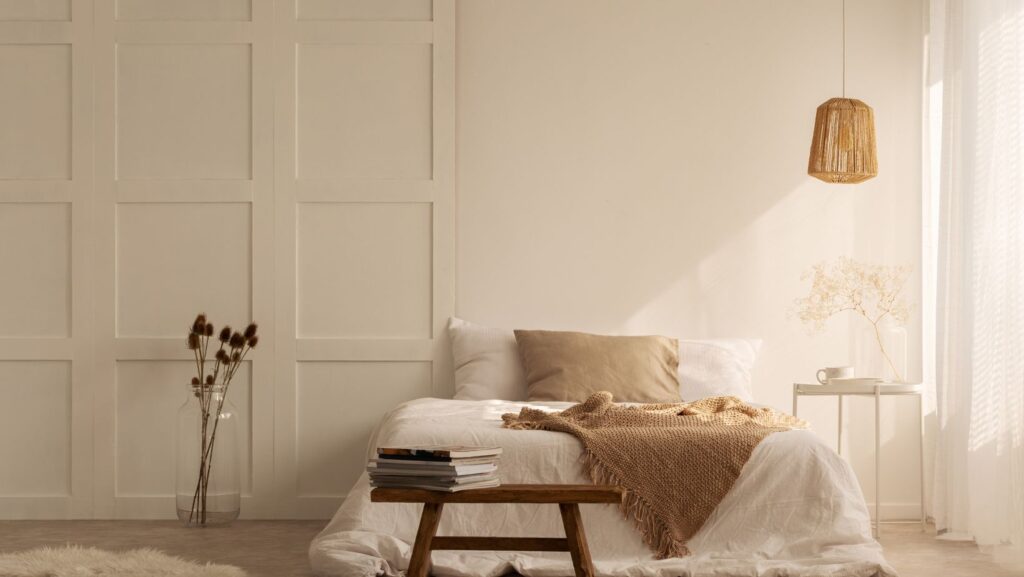When most people think of “Zen,” they think of tranquility and calm. But what if Zen could also be implemented into your home? With a few simple tips, you can add some zen flair to your home without sacrificing comfort or style. In this blog post, we’ll take a look at eight key elements of Zen design. So, if you’re ready to transform your home into a haven of peace and serenity, keep reading!

What Does “Zen” Mean?
The word “zen” is the Japanese pronunciation of the Chinese word 禪 (chán), which in turn is a Chinese transliteration of the Sanskrit word ध्यान (dhyāna), meaning “meditation”. (1)
Zen is a school of Buddhism that emphasizes the practice of meditation as a means of enlightenment. The goal of Zen is to achieve a state of inner peace and tranquility. Through meditation, practitioners can learn to quiet their minds and focus on the present moment. This can lead to a deeper understanding of oneself and the world around them while promoting physical and mental well-being.

What Is a Zen-Inspired Interior Design?
Zen interior design is all about creating a space that promotes peace and relaxation. The goal is to create a haven from the hustle and bustle of daily life, where you can unwind and recharge. To achieve this, Zen-inspired spaces typically feature clean lines, natural materials, and neutral colors. Furniture is often minimal, and surfaces are kept clear to promote a sense of order and calm. Natural light is also important in creating a Zen atmosphere, so windows are often left uncovered to allow in as much sunlight as possible. In addition to promoting relaxation, Zen interior design can also help to boost focus and creativity. By decluttering your space and getting rid of distractions, as well as adding relaxing elements such as an hourglass rainmaker, candles, or a wind chime, you can create an environment that is conducive to concentration and productivity.

How to Create a Serene Zen Interior
Less Is More
A well-edited room tends to be more visually appealing than one that is crammed full of furniture and knick-knacks. One of the key benefits of this approach is that it can help to make small spaces feel larger and more open. When there are fewer objects on display, each one can be given more attention, and the eye is not drawn to any one particular area. In addition, a minimalist approach can also help to create a sense of order and calm, making it ideal for a Zen home.

Neutral Color Palette
When it comes to creating a Zen-inspired interior, one of the most important things to keep in mind is choosing a natural color palette. Colors like white, cream, beige, and gray can help to create a sense of calm and tranquility. Avoid brighter colors like red or yellow, which can be jarring and disruptive. Instead, stick to muted tones that will help you create a serene and relaxing space, and implement greens and blues as accent colors.

Natural Elements
Incorporating stone, wood, greenery, and water features into your design will give your space an organic feel that will help you to relax and recharge. Incorporating these elements does not have to be expensive or difficult – a few simple changes can make a big difference. For example, placing stones or pebbles in a bowl can add a natural accent to any room. Potted plants are another inexpensive way to bring nature into your home, and they can help purify the air as well. A bonsai tree would be ideal for the Zen look. If you have the space, adding a water feature such as a fountain or small pond can create a truly tranquil atmosphere.

Natural Light
Sunlight has a calming effect on the mind and body, and it can also help to improve mood and focus. In addition, natural light is an essential part of the cycle of nature, and it helps to regulate our bodies’ circadian rhythms. For these reasons, it’s important to make sure that your Zen-inspired interior receives plenty of light.

Streamlined Furniture
One of the best ways to achieve a zen interior design is to choose furniture that is simple and clean in design. Streamlined furniture is often made with natural materials such as wood, stone, or bamboo, and features straight lines and smooth surfaces. This type of furniture creates a feeling of calm and tranquility, which is perfect for achieving a zen state of mind. To add to the impression of balance, search for Japanese-style low-to-ground furnishings. It will help you keep your room’s visual flow uninterrupted while also allowing you to feel more grounded.

Sliding Doors
These doors offer a simple and elegant way to divide space, and their clean lines can help to create a sense of calm. In addition to their visual appeal, sliding doors are also extremely practical., they are easy to operate and can be opened to let in natural light or fresh air. When closed, they provide a sense of privacy and seclusion which is ideal if you want to create a private retreat or meditative space.

Floor Cushions
Floor cushions are a great way to add extra seating without taking up too much space, and they can create a cozy, inviting atmosphere. They can be used as padding for yoga or meditation as well. They come in a variety of sizes and shapes, so you can find the perfect fit for your space.

Natural Textiles
If you’re looking for a more Zen home, start by considering these 8 key elements of Zen interior design. With just a few changes, you can create a calm and relaxing space that will help you de-stress and center yourself. What’s your favorite element of Zen design?








